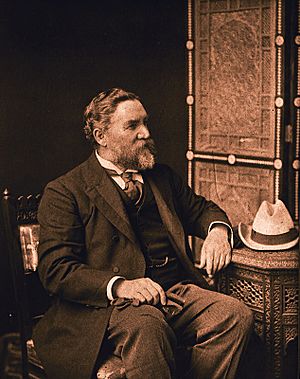George Watt (botanist) facts for kids
Sir George Watt (born April 24, 1851 – died April 2, 1930) was a Scottish doctor and botanist. He worked in India and became famous for his huge multi-volume book, The Dictionary of Economic Products of India. This book, finished in 1893, described many useful plants and products from India. Later, a shorter version called Commercial Products of India was published in 1908. Many plants have been named after him to honor his work.
Contents
Early Life and Career in India
George Watt was born in Old Meldrum, Scotland. He studied at several universities, including the University of Aberdeen and the University of Glasgow, where he earned medical degrees in 1873. He enjoyed teaching and even worked as an anatomy assistant at Glasgow University.
Around 1864, a terrible famine happened in a part of India called Orissa. To help prevent future famines, leaders in India realized they needed to improve farming and study plants scientifically. Because of his skills, George Watt was chosen to become a Professor of Botany at Presidency College in Calcutta (now Kolkata), India, in 1873.
He taught for ten years and started collecting and studying local plants. He was very careful to label his plant samples correctly. In 1879, he traveled through northwest Punjab and found several new plant species in the Chamba area.
Important Exhibitions and Publications
In 1881, George Watt worked as a surgeon for a special group mapping the border between Burma and Manipur. During this trip, he also studied plants. When he returned, he was put in charge of the Calcutta International Exhibition in 1883–84. He created a huge catalogue for the exhibition's economic section. This catalogue was later expanded and became the first part of his famous "Dictionary of Economic Products of India." For his excellent work, he received an honor called CIE.
After this, he was put in charge of the Indian Museum and became the "Reporter on Economic Products" for the government. This meant he was responsible for collecting and sharing information about useful plants and products from all over India. He also edited a government newsletter called The Agricultural Ledger, which shared notes on farming and products. He even wrote books about important crops like cotton and cacao.
Throughout his time in India, George Watt held many important roles. He was involved in exhibitions, worked for the government on economic products, and even directed an Indian Art Exhibition in Delhi in 1903.
Outside of his work, he was also interested in missionary activities in India. In 1873, he married Jane Simmie, and they had a son and two daughters.
Retirement and Later Years
George Watt retired in 1906 and moved back to Lockerbie, Scotland. Even in retirement, he continued his passion for botany. For five years, he gave lectures on Indian trees to students at Edinburgh University. He also wrote a book about the Primulas (a type of flower) found in India.
He visited the island of São Tomé in 1912. In Lockerbie, he was active in his community, serving as a County Councillor and a Justice of Peace. He also helped develop the gardens at the Crichton Royal Institution in Dumfries. Sir George Watt passed away at his home in Lockerbie on April 2, 1930.
Awards and Honours
Sir George Watt received many awards and honors for his important contributions to botany and his work in India.
- In 1901, he won the Daniel Hanbury Gold Medal.
- He was knighted in 1903, which means he received the title "Sir."
- He was also recognized by several scientific societies, including being a Fellow of the Royal Society in Haarlem.
To honor his work, several plants were named after him, including:
- A type of rhododendron called Rhododendron wattii.
- A kind of iris called Iris wattii.
- Other plants like Eranthemum wattii, Clematis wattii, and Primula wattii.



